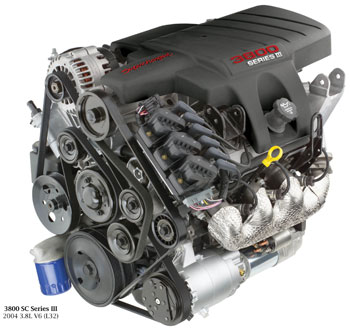 The Buick 231 cu. in. 3.8L V6 engine has had a production run lasting more than 30 years. Like the small block Chevy V8, this engine has undergone many changes over the years to keep it abreast of changing consumer expectations and emissions regulations.
The Buick 231 cu. in. 3.8L V6 engine has had a production run lasting more than 30 years. Like the small block Chevy V8, this engine has undergone many changes over the years to keep it abreast of changing consumer expectations and emissions regulations.
The first Buick 3.8L was offered in the 1975 model year Skyhawk, Apollo, Century and Regal. The engine was based on an earlier 198 cu. in. V6 that Buick introduced back in 1962. The 3.8L engine shared the same 3.8” bore size as the Buick 350 V8. It also had an “odd-fire” crankshaft, which produced some idle shake and vibration.
Over the years various improvements were made to upgrade engine performance. Here are some of those changes:
1977 — Buick changed to an “even-fire” offset-pin crankshaft to smooth out the V6 engine.
1978 — Turbocharged version of the 3.8L V6 offered in the Buick Regal and LeSabre.
1979 — The engine gained some horsepower with improved cylinder heads (larger valves and ports).
1980 — Larger 4.1L version of 3.8L engine offered with bigger 3.965” pistons.
1981 — Stronger connecting rods and a revised harmonic balancer and flywheel were added.
1982 — 180 hp version of the turbocharged 3.8L V6 offered in Regal T-Types and Grand National. Also, a smaller displacement 3.0L version of the 3.8L V6 with a shorter stroke crankshaft was built for GM FWD cars.
1984 — Direct fire distributorless ignition and electronic multiport fuel injection were added. Also a new camshaft with a larger base circle and 0.015” shorter pushrods were added. This was also the first year for a front-wheel drive (FWD) version of the 3.8L V6.
1985 — The engine was refitted with a single serpentine belt to drive its accessories. The number of bolts on the oil pan was also increased from 14 to 20 to reduce oil leaks. The head bolts also changed to non-reusable torque-to-yield bolts.
1986 — The flat tappet lifters were upgraded to roller lifters to reduce internal engine friction, and sequential fuel injection was also added for improved performance, fuel economy and emissions. The deck height of the block was also reduced 0.035” to accommodate thicker composition-style head gaskets. Some FWD versions of the 3.8L V6 (VIN 3) were offered with roller lifters. FWD versions also got new cylinder heads with pedestal-style rocker arms, and a needle bearing thrust washer for the camshaft.
1988 — Buick now dubbed the engine the 3800. The block casting was revised and a balance shaft added to dampen vibrations. The cast iron camshaft was replaced with a steel camshaft, thinner, low-tension piston rings were added to reduce friction even more, and the mechanical EGR valve was replaced with an electronic digital EGR valve to reduce NOx emissions.













